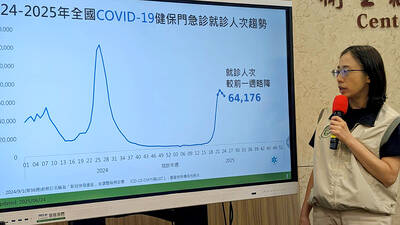Taiwan may be an island, surrounded by sea, but a recent survey has shown that people in the nation fared poorly in their knowledge of the oceanic environment.
The survey, carried out by Taiwan Environmental Info Association (TEIA), asked 600 fifth and sixth-graders and some adults about their understanding of Taiwan’s maritime landscape. Results showed that less than 50 percent of respondents knew that the country’s coastline is 1,600km long and only 43 percent could accurately name Fugueijiao (富貴角) as the northernmost end of Taiwan.
Meanwhile, only 48 percent knew that the nation’s largest lagoon is located in Cigu District (七股) in Greater Tainan.
While the heavily polluted algal reef in Taoyuan County’s Guanyin Township (觀音) has garnered much media attention recently, 75 percent of the respondents did not know it was the nation’s largest algal reef, and about 40 percent thought it was in Taitung County.
The survey also found that 70 percent of respondents did not know that Dongsha Atoll National Park is the nation’s only marine national park. While 95 percent of the respondents said they like the sea, 50 percent of them reported that they do not go to the beach regularly.
With yesterday marking World Oceans Day, TEIA secretary-general, Chen Juei-ping (陳瑞賓), said the survey findings showed that there was an urgency to reinforce education about Taiwan’s marine environment.
“Most people’s understanding of the sea is still limited to eating seafood and playing water sports,” he said. “If people fail to possess even a basic knowledge of the ocean, the nation will lose the opportunity to react in time to the challenges brought about by climate change.”
As part of its efforts to educate the public about the sea environment, TEIA and Standard Chartered Bank have started a project to draw a map of the country’s coastline biodiversity, which is scheduled to be finished in January next year.
TEIA Environmental Trust Center director Sun Hsiu-ju (孫秀如) said all the information they gather will be put online and will be available to the public free of charge.
Taiwan’s first coastline map was drawn up by Dutch explorers in 1636 in which they delineated the shoal and the inter-tidal zone along the nation’s west coast near Dacheng (大城), Changhua County.
“From the [Dutch] maps, we can see that Taiwan is getting ‘skinnier’ because of coastline erosion and subsidence,” Sun said.
In related developments, the Fisheries Agency announced yesterday that the nation now has three levels of sea protection zones. For Type I zones, access is granted only to scientists and government officials charged with monitoring and restoring the environment and they are not allowed to damage the area’s eco-systems in any way.
Those entering Type II zones are banned from engaging in developing any of the natural or cultural resources and in Type III zones only limited development is permitted, which must be conducted under the principle of sustainable development, it said.

China might accelerate its strategic actions toward Taiwan, the South China Sea and across the first island chain, after the US officially entered a military conflict with Iran, as Beijing would perceive Washington as incapable of fighting a two-front war, a military expert said yesterday. The US’ ongoing conflict with Iran is not merely an act of retaliation or a “delaying tactic,” but a strategic military campaign aimed at dismantling Tehran’s nuclear capabilities and reshaping the regional order in the Middle East, said National Defense University distinguished adjunct lecturer Holmes Liao (廖宏祥), former McDonnell Douglas Aerospace representative in Taiwan. If

Prosecutors in New Taipei City yesterday indicted 31 individuals affiliated with the Chinese Nationalist Party (KMT) for allegedly forging thousands of signatures in recall campaigns targeting three Democratic Progressive Party (DPP) lawmakers. The indictments stem from investigations launched earlier this year after DPP lawmakers Su Chiao-hui (蘇巧慧) and Lee Kuen-cheng (李坤城) filed criminal complaints accusing campaign organizers of submitting false signatures in recall petitions against them. According to the New Taipei District Prosecutors Office, a total of 2,566 forged recall proposal forms in the initial proposer petition were found during the probe. Among those

ECHOVIRUS 11: The rate of enterovirus infections in northern Taiwan increased last week, with a four-year-old girl developing acute flaccid paralysis, the CDC said Two imported cases of chikungunya fever were reported last week, raising the total this year to 13 cases — the most for the same period in 18 years, the Centers for Disease Control (CDC) said yesterday. The two cases were a Taiwanese and a foreign national who both arrived from Indonesia, CDC Epidemic Intelligence Center Deputy Director Lee Chia-lin (李佳琳) said. The 13 cases reported this year are the most for the same period since chikungunya was added to the list of notifiable communicable diseases in October 2007, she said, adding that all the cases this year were imported, including 11 from

The Ma-anshan Nuclear Power Plant’s license has expired and it cannot simply be restarted, the Executive Yuan said today, ahead of national debates on the nuclear power referendum. The No. 2 reactor at the Ma-anshan Nuclear Power Plant in Pingtung County was disconnected from the nation’s power grid and completely shut down on May 17, the day its license expired. The government would prioritize people’s safety and conduct necessary evaluations and checks if there is a need to extend the service life of the reactor, Executive Yuan spokeswoman Michelle Lee (李慧芝) told a news conference. Lee said that the referendum would read: “Do